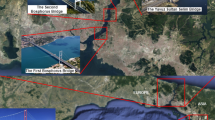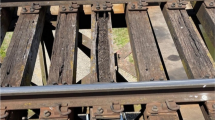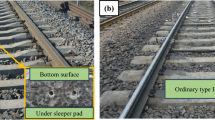Abstract
The optimal construction of long-span ziplines represents a complex engineering and construction task, especially from a safety point of view. In contemporary literature and engineering practice, there are no appropriate theoretical bases, standards and recommendations directly related to this issue. The aim of this work is to try to define the appropriate theoretical and professional basis for the design of these devices. The paper describes the procedure for creating a mathematical model of a zipline, followed by experimental verification of the formed mathematical model on a particular zipline, and afterwards by an analysis of the influencing parameters. The beginning of the paper defines the theoretical background that is necessary for the mathematical model forming of descending a rider down a heavy rope that takes into account mechanical and aerodynamical resistances that occur during the descent, after which a description of formation of the model itself is given. The next part of the paper gives a detailed description of the zipline on which the measurements were made, and a complete description of the used measuring equipment. Then succeeding part contains measurement results, followed by verification of the mathematical model by comparing the measured and calculated values. In the end, the influence of relevant parameters are analyzed by using the mathematical model and adequate conclusions are drawn.






























Similar content being viewed by others
Data availability
The data that support the findings of this study are available from the corresponding author upon reasonable request.
References
How to Build A Zip Line by Kerrianne Rudderow. https://www.ziplinestop.com/blogs/how-to-build-a-zip-line/how-to-build-a-zip-line#:~:text=Cable%20Slope,foot%20drop%20per%20100%20feet. Accesed 10 January 2023
Ziplinegear. https://www.ziplinegear.com/pages/how-to-build-a-zip-line-section-one-concepts. Accesed 10 January 2023
Backyard Ziplines. https://backyardziplines.com/pages/how-to-build-a-zip-line-section-two-cable-installation. Accesed 10 January 2023
Alamoreanu, M., Vasilescu, A.: Study of gravitational displacements of a mobile load on ropeway cable. Acta Technica Napocensis 60(4), 445–450 (2017)
Rukavina, T., Kožar, I.: Analysis of two time-delayed sliding pendulums. Eng. Rev. 37(1), 11–19 (2017)
Rukavina, T., Kožar, I.: Analysis of two masses sliding along a cable with delay. In: International Conference on Applied Mathematics and Computational Methods in Engineering, pp. 61–64 (2015)
Kožar, I., Torić-Malić, N.: Analysis of body sliding along cable. Coupled Syst. Mech. 3(3), 291–304 (2014). https://doi.org/10.12989/csm.2014.3.3.291
Czitary, E.: Seilschwebebahnen. Springer, Vienna (1962)
Vladić, J.: Computational and Experimental Methods for Static and Dynamic Analysis of Ropeways. Faculty of Technical Sciences, Novi Sad (1991)
Dukel’skiy, A.I.: Podvesnye kanatnye dorogi i kabelʹnye krany. Mashinostroenie, Moscow (1966)
Anderson, J.: Fundamentals of Aerodynamics. McGraw-Hill Education, New York (2017)
Samset, I.: Winch and cable systems. Norwegian Forest Research Institute, Ås (1985)
Kuybida, G.G.: Kabel’nye krany. Mashinostroenie, Moscow (1989)
Barat, I.E., Plavinskij, V.I.: Kabel’nye krany. Mashgiz, Moscow (1954)
Diviziev, V.I.: V’ženi linii i kabelni kranove. D’ržavno izdatelstvo “Tehnika”, Sofia (1975)
Lv, J., Kang, H.: Nonlinear dynamic analysis of cable-stayed arches under primary resonance of cables. Arch. Appl. Mech. 88(4), 573–586 (2018). https://doi.org/10.1007/s00419-017-1328-8
Wenin, M.: Analytical solution of the eigenvalue problem for the elastic cable loaded with a mass point. Arch. Appl. Mech. 92(12), 3649–3660 (2022). https://doi.org/10.1007/s00419-022-02254-7
Vladić, J., Đokić, R., Jovanović, M.: Steel Rope and Computational–Experimental Procedures for the Analysis of Specific Transport machines. Faculty of Technical Sciences, Novi Sad (2019)
Vladić, J., Đokić, R., Jojić, T.: Elaborate: Analysis of the Zip-line System in Vrdnik. Faculty of Technical Sciences, Novi Sad (2017)
Jojić, T., Vladić, J., Đokić, R., Zelić, A.: Basis for simplified zipline model analysis. In: Proceedings of 10th International Scientific Conference IRMES 2022, pp. 178–183 (2022)
BS EN 15567-1:2007: Sports and Recreational Facilities: Ropes Courses. European Committee for Standardization, Brussels
Australian Institute of Health and Safety. https://www.aihs.org.au/news-and-publications/news/whsq-issues-safety-alert-zip-line-terminations. Accesed 13 January 2023
Work Safe. https://www.worksafe.qld.gov.au/news-and-events/alerts/workplace-health-and-safety-alerts/2019/safety-alert-zip-line-terminations. Accesed 13 January 2023
Gross, A.C., Kyle, C.R., Malewicki, D.J.: The aerodynamics of human-powered land vehicles. Sci. Am. 249(6), 142–153 (1983)
Koo, M.H., Al-Obaidi, A.S.M.: Calculation of aerodynamic drag of human being in various positions. Proc. EURECA 2013, 99–100 (2013)
Schmitt, T.: Wind-Tunnel Investigation of Air-Loads on Human Beings. Navy Department—The David W. Taylor Model Basin, Aerodynamics Laboratory, Washington DC (1954)
Hoerner, S.F.: Fluid-Dynamic Drag: Theoretical, Experimental and Statistical Information. Published by the Author, Washington, DC (1965)
Jojić, T., Vladić, J., Đokić, R.: Determination of Zipline Braking Distance. In: Machine and Industrial Design in Mechanical Engineering (Proceedings of KOD 2021). Springer Nature, Cham. https://doi.org/10.1007/978-3-030-88465-9_72 (2022)
Funding
The authors did not receive support from any organization for the submitted work. This paper is financed by the authors themself.
Author information
Authors and Affiliations
Corresponding author
Ethics declarations
Competing interests
The authors declare that they have no competing interests.
Additional information
Publisher's Note
Springer Nature remains neutral with regard to jurisdictional claims in published maps and institutional affiliations.
Rights and permissions
Springer Nature or its licensor (e.g. a society or other partner) holds exclusive rights to this article under a publishing agreement with the author(s) or other rightsholder(s); author self-archiving of the accepted manuscript version of this article is solely governed by the terms of such publishing agreement and applicable law.
About this article
Cite this article
Jojić, T., Vladić, J. & Đokić, R. Zipline mathematical model forming, experimental verification and analysis of influential parameters. Arch Appl Mech 93, 4157–4180 (2023). https://doi.org/10.1007/s00419-023-02487-0
Received:
Accepted:
Published:
Issue Date:
DOI: https://doi.org/10.1007/s00419-023-02487-0




